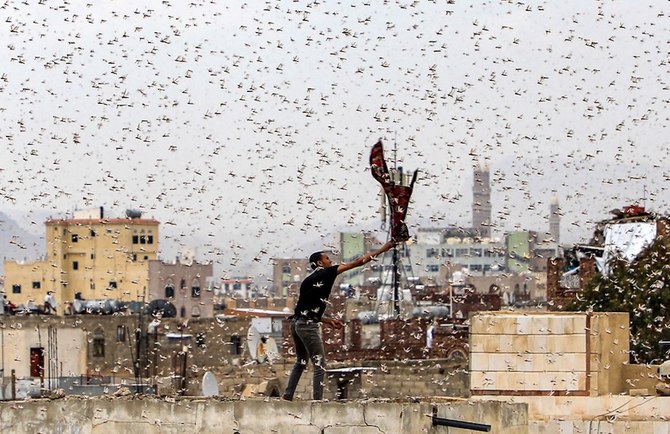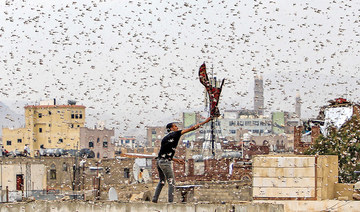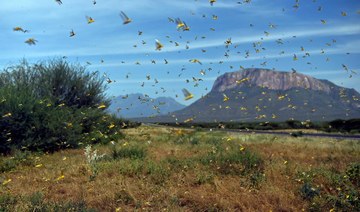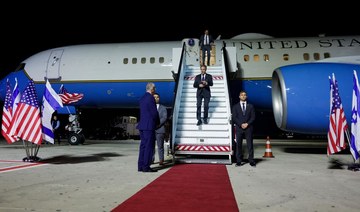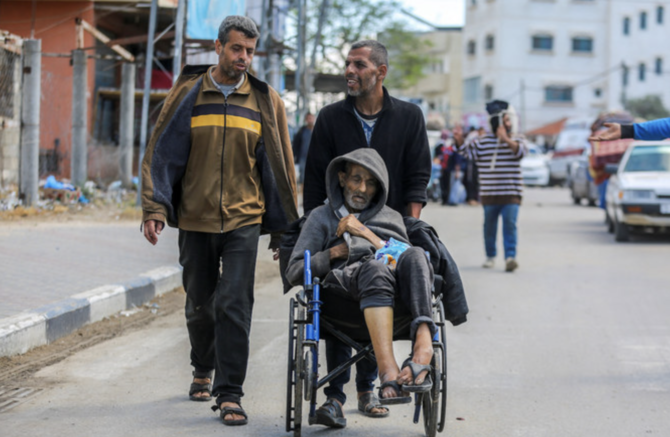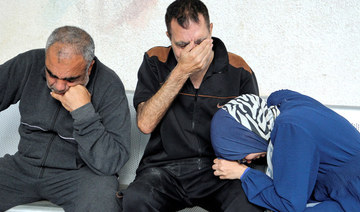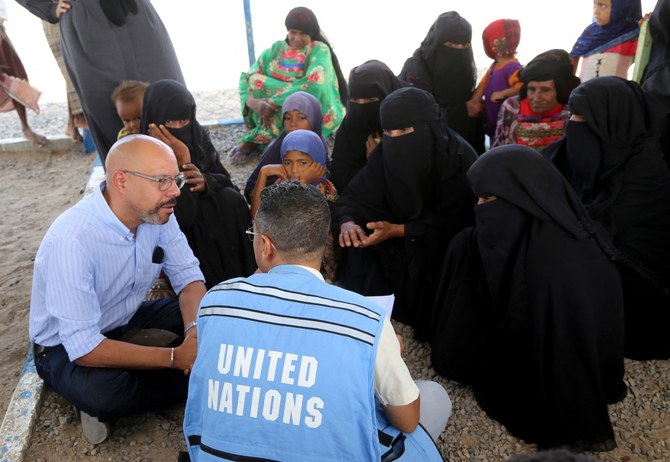DUBAI: Battling an unprecedented pandemic that has infected more than 12 million people globally, countries in the Middle East and South Asia find themselves saddled with more bad luck.
Swarms of locusts have invaded 23 countries across East Africa, the Middle East and South Asia, including the UAE, Saudi Arabia and neighboring countries, with India becoming the latest victim.
According to the UN’s Food and Agriculture Organization (FAO), the swarms of desert locusts represent the worst infestation for 25 years in Ethiopia and Somalia, 26 years in India and 70 years in Kenya.
The World Bank believes this single outbreak of locusts could cover 20 percent of the Earth’s landmass if it reaches plague levels.
It is easy to underestimate the seriousness of the locust infestation at a time when people are grappling with a global economic turndown and rising joblessness in the wake of COVID-19. However, as these grasshoppers make their way around the region, they are mounting a serious attack on the world’s harvests and food supplies.
In the Arabian Peninsula, locust swarms have swept over farms in central, southern and eastern parts of Yemen. Residents and farmers in Marib, Hadramout, Mahra and Abyan say billions of locusts have invaded farms, cities and villages, devouring seasonal crops such as dates and causing heavy losses.
Images and videos posted on social media in recent days show swarms of locusts laying waste to lemon farms in Marib and dates and alfalfa farms in Hadramout.
In February, large groups of locusts were seen in farms and rural areas in Saudi Arabia and Yemen, after traveling from the sub-Saharan African region as well as neighboring countries such as Oman and India.
Four of Saudi Arabia’s main agricultural areas in Riyadh, Qassim, Hail and the Eastern Province were affected by the invasion, as insects ravaged crops in Jazan, Asir, Al-Baha, Al-Leith, Qunfodah and Makkah.
FASTFACTS
Locusts
* Belong to Acrididae family of grasshoppers.
* Most destructive migratory pest in the world.
* Small swarm can comprise 80 million grasshoppers and consume amount of food that 35,000 people would in a day.
* Desert locust eats roughly its own weight (2 gm) in food each day.
Mohammad Al-Shammrani, director of combating locusts and plagues at the Ministry of Environment, Agriculture and Water in Saudi Arabia, had previously told Arab News that the locusts came from East Africa.
“The Kingdom has been combating locusts on a daily basis since the beginning of January, successfully exterminating the first generation of the insect’s invasion,” he said.
While specialized teams are constantly monitoring the movement of swarms into the Kingdom, the UAE has also been taking precautions to protect its farms.
The Abu Dhabi Agriculture and Food Safety Authority reported in mid-February that it had exterminated small gatherings of locusts using pesticides in a six square-kilometer area of farmland on Dalma island.
The agency has revised its level of preparedness to confront any new group of desert locusts coming from the “Arabian Peninsula and the Red Sea coasts.”
------
READ MORE: Locust invasion in Yemen stokes food insecurity fears
Saudi specialist teams to fight locust invasion
Dubai Municipality reassures residents after swarms of locust spotted, ‘situation under control’
------
Oman reported a locust attack in early February as millions of insects infested multiple governorates in the country. Authorities deployed 37 teams at South Al-Sharqiyah, Al-Wusta and Muscat to destroy the swarms and protect the crop fields. However, the locusts quickly made a comeback in May.
“The locust outbreaks are linked to more than normal rains in sub-Saharan Africa, Arabian Peninsula and the Thar desert in Pakistan and India as the swarms follow the wind currents,” Hari Chand Sharma, an Indian entomologist and agricultural scientist, told Arab News.
Many may question the real impact of locusts, but the answer is simple: The insects are extremely dangerous when traveling in swarms.
The desert locust, which belongs to a family of grasshoppers called Acrididae, is considered the most destructive migratory pest in the world. They are highly mobile and can form swarms containing millions of locusts, leading to devastating impacts on crops, pasture and fodder.
According to the World Bank, a small swarm (one square kilometer) can comprise 80 million locusts and consume the same amount of food that 35,000 people would in a day. Additionally, a large swarm can eat up to 1.8 million metric tons of green vegetation, equivalent to the amount of food required for 81 million people.
While they do not attack humans and animals or spread disease, locusts breed very fast. A single female locust can lay pods containing 80 to 150 eggs.
Sharma believes that during this year’s monsoon season, the swarms will largely be confined to India and Pakistan or may move to Nepal. “The locust outbreak was triggered by excessive summer rains in Africa and heavy winter rains in Asia,” he told Arab News.
According to Sharma, the locust outbreak originated in the eastern part of sub-Saharan Africa (Ethiopia, Eritrea, and Northern Kenya). “From there the locusts moved to the Arabian Peninsula, Iran, Afghanistan and western Pakistan. The swarms from these areas then invaded Sindh in Pakistan and Rajasthan in India (Thar desert) in March. In June, the swarms moved to central and northern parts of India,” he said.
In June, swarms of locusts moved into India’s National Capital Region, ravaging sugarcane fields and raising the specter of major losses for the country’s agriculture sector.
Despite efforts to douse crops with pesticides, the Indian government has struggled to contain the worst locust assault in decades with the monsoon season around the corner promising more destruction. In 2003, the damage to crops and trees by locusts was estimated to be more than $2.5 million, Sharma said.
He believes the attack is not yet over. “The populations that multiply in southern Asia will move to the Arabian Peninsula and then to Africa in the spring and winter,” Sharman said.
He underscored the need for greater attentiveness from affected countries to the multiplication of the grasshoppers in desert areas. “It is important to undertake timely control operations when the insects are without wings (nymphal stage) in the initial stages,” he told Arab News.
“During this period, to control the pest, the Locust Warning Organization under the FAO and government agencies should use microbial agents such as the fungus Metarhizium, the protozoa Nosema locustae and insecticides, which will be least disruptive to the environment.”
The World Bank Group has approved a $500 million program to provide flexible support to affected countries in Africa and the Middle East. Without broad-scale efforts to control a rapidly evolving crisis, the bank puts a conservative estimates of losses — including for staple crops, livestock production and asset damage — at $8.5 billion for countries in the wider East Africa region, Djibouti and Yemen.
A world contending with the havoc wrought by an invisible virus may soon find itself in an escalating battle with a more visible but no less ruthless invader.
-----------------------
Twitter: @jumana_khamis



